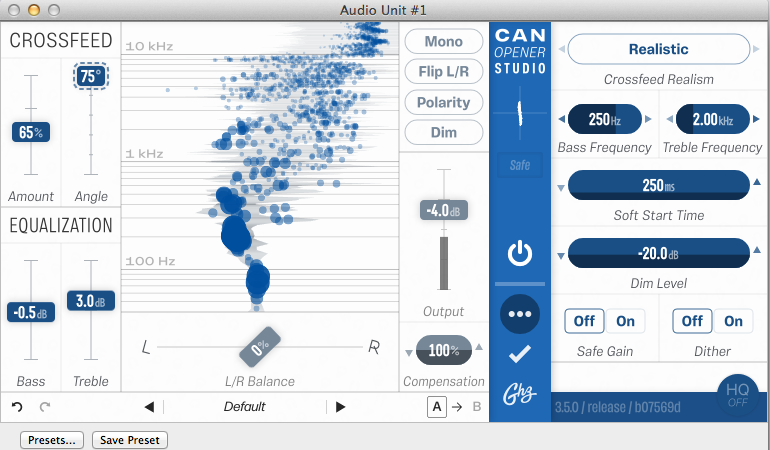


The only thing I did is decouple ITD from ILD tunables. Specifically, the improved 3-channel variant of his, as described on this page: Meier's advanced crossfeed is exactly what I do. 20, and a change to around 1400hz in the f-central value made the signal sound almost identical to meiers medium setting. It turns out my setting on headfit was a little too high(thin) and a setting of. I was just listening to the files at the meier site here by the way and tried out the samples of crossfeed vs no crossfeed and tweaked headfit to get a naturalness similar to the medium setting channel test. So when a crossfeed plugin is introduced, the sound usually becomes either like a bloated speaker with decent imaging or a thin sounding speaker with decent imaging all depending on whether the crossfeed plugin adds or subtracts bass. The thing about trying to simulate speakers with a crossfeed circuit is that the usual monitor type headphone for example has a frequency response targeted to sound natural without any plugins. All I want is the same headphone sound with less fatigue. I don't want to feel like my headphones are being toed in or put farther away from me. I just want a deaf ear effect elimination with minimal coloring of the sound. All I am saying is that what I want is something more like the meier natural crossfeed over headrooms crossfeed implementation for example. I am not saying that it fails to simulate speakers so far as imaging is concerned more than other crossfeed plugins. I still find your crossfeed to be too congested for my taste. Without head tracking, that's as far as you can go. Just add real life reflections (say, measured mono or better, dual mono convolution reverb) and you're set. The whole idea is that if your IEMs/headphones are reasonably linear (preferably equalized), they simulate a true mono source when given a mono signal. The combing in any reasonably reverberant room is more complex and usually not as deep and wide as head-fit's ITD-related combing. My crossfeed, which simulates a 3-channel setup, specifically avoids this artifact. (while head-fit starts combing lower at most settings) Center combing is an undesirable stereo artifact actually - true mono speaker and live sound in front do not exhibit that, it's well hidden in non-anechoic-chamber stereo by the room combing and speaker nonlinearities, there's less of it than that. Not really, the frequencies leak linearly until 3000 Hz or so. "Wightman and Kistler (1997) found that the fact that ITD is frequency dependant and is larger at low frequencies than at high frequencies (Kuhn, 1977) is perceptually irrelevant." Now, I need the actual measurements of this for homo sapiens. <- Springer be damned for their pricing. In birds, the curve is very slightly U-shaped - almost flat with a boost in bass. Spherical model has an ITD hump similar to ILD. I will will not implement frequency-dependent ITD as well, possibly with a separate filter from ILDs - since it looks to be linear.
MEIER CROSSFEED PLUS
Plus the controls are quite tricky to set up - I prefer the new ones in my filter, the angle has a direct physical representation. However, its ITD control is too low granularity - people can resolve even 6 us at some frequencies (near 1kHz), 2.5 degrees in spherical model. (To see head-fit's combing, use correlated noise in its generator.) Yes, head-fit is plenty good, except it's combing the signal in excess due to incorrect FIR filtering (no delay adjustment) and feeding into the center/mono channel causing yet more combing.


 0 kommentar(er)
0 kommentar(er)
